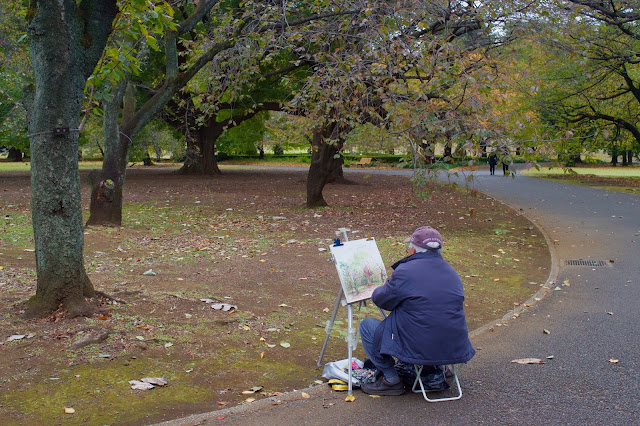All photos are by the author © John R Stiles 2016. It is illegal to use any photo without permission. For information, write to jsscience@yahoo.com.
KYOTO
 |
| A peek into the kitchen of a restaurant in Kyoto's Gion area. This part of Kyoto is a walker's paradise: interesting shops, temples, cobbled streets, and oozing with charm. |
 |
| A traditional hand washing station at a temple. The Japanese take great pains to design around and include nature. |
 |
| Traditional rickshaws are available for hire in Gion. |
 |
| This restaurant scene through the window design drew my attention. Many restaurants are tiny and cozy, like this one. |
 |
| Everything about this restaurant scene fascinated me: the chef, casually hung umbrella (it was raining), the sign and passing pedestrians gave it a balanced, and somewhat surreal effect. |
 |
| Pagoda at To-Ji ("East") Temple, southwest of the Kyoto train station. It is the tallest wooden tower in Japan. The entire grounds of the temple have been designated a World Heritage Site. The temples are also made entirely of wood and house magnificent wooden statues of Buddha statues and other related deities. |
 |
| Umbrellas neatly lined up outside of a gift shop as their owners browse merchandise. |
Rikugien Gardens
"Rikugi-en" means "Garden of the Six Principles of Poetry" and is landscaped to reflect Waka style poetry. A serene park for strolling and reflecting.
 |
| This sculpted pine tree seemed to have an iconic Japanese shape. |
 |
| Togetsukyo Bridge, a beautiful site in the gardens. It was named for a famous waka poem in which the moon moves across the sky and the cry of a crane can be heard from a rice paddy. |
 |
| Brilliant autumn color in the gardens. |
 |
| A pleasing scene at one of the ponds in the park. |
This National Garden is vast and beautiful, with many paths through groves of trees, along meadows, a Japanese garden and French rose garden.
 |
| The huge trees in Shinjuku Gyoen were ablaze with a mix of colors. It was striking. |
 |
| Surprisingly, I saw no other artist in the park, but there were many photographers, some serious, some casual. |
 |
| One of hundreds of beautiful blooms in the French garden. |
 |
| A stunning stand of large trees along the path. |
 |
| Gingko leaves. |
 |
| Rose in the French garden. |
 |
| A Tai Chi practitioner |
Ueno Park
Ueno Park, Tokyo's most popular park, is near Ueno Train Station. Famous for its spring cherry blossoms, it is also beautiful in autumn. The biggest difference is that the throngs of people that mass in spring are largely absent in autumn. The park is Tokyo's largest (300 acres) and houses many influential museums, temples, the national zoo, and... a Starbucks.
 |
| A bit early for the peak colors, the trees were nonetheless beautiful. |
 |
| Also known as the "Fox Temple", it honors the spirit of foxes, as this guardian fox shows. Japanese believe very strongly in animal spirits. |
 |
| Entrance to Toshogu Shinto Shrine ("Golden Shrine") near the zoo. |
 |
| Reflections in puddles from a recent rain. |
 |
| Three of the dozens of stone lanterns that border the path to the shrine. |
 |
| View of the shrine's gilded main entrance. |
 |
| View of the National Museum. |
 |
| Schoolboys and a jogger share a path under the colorful spreading trees in Ueno Park. |





